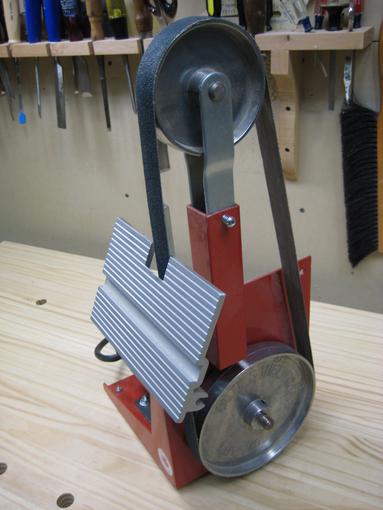
I use this little belt grinder to prepare the primary bevels on my planes and chisels. It works great!
Why I like it
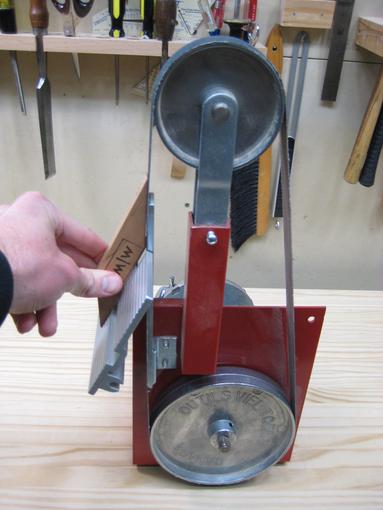
I like that this machine is small, simple and comes completely setup. You don’t have to do any modifications to start grinding planes and chisels.
The table tilts down all the way to 155°, which allows you to grind a 25° bevel. To set the bevel, I use a little setup block, which you can see to the right.
The table pivots at a single point and slides back and forth, which allows for the wide range of angles. The pivot mechanism is just a friction fit, but it seems to stay put well enough.
To grind a bevel, I wrap my fingers from both hands over the top of the table and use my thumbs to control the blade. It takes a little bit of practice, but is certainly much easier than using a wheel grinder.
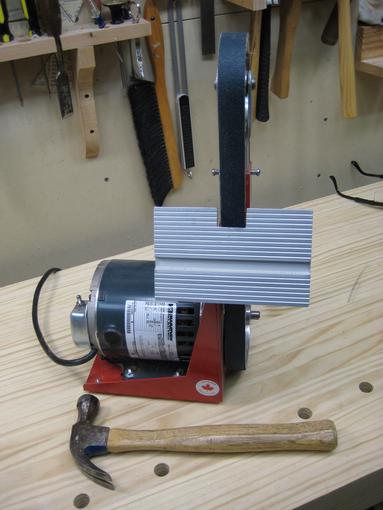
For belts, I use three grits, 40, 80, and 120, all of them zirconia. I bought one of each and haven’t replaced any yet, so I’m not sure how long they last. You can get many, many grindings out of each belt.
I am careful, but have very few problems with the blade heating up, especially with the courser abrasives. Yes, courser abrasives grind cooler.
The belt tension is controlled by a simple spring. You can’t adjust it, but I’ve never needed to. To change a belt, you simply slide the table back, push on the top wheel, take the belt off, and then put the new one on. It could not be easier.
Belt tracking is controlled by two square drive screws, one on each side of the vertical column. You simply tighten or loosen each side to change the tracking. I do not need to adjust tracking very often. The mechanism is simple and works great.
The platen (metal piece behind the belt) is stiff, sturdy, and flat enough for sharpening.
Criticisms
Nothing is perfect, so here are my criticisms.
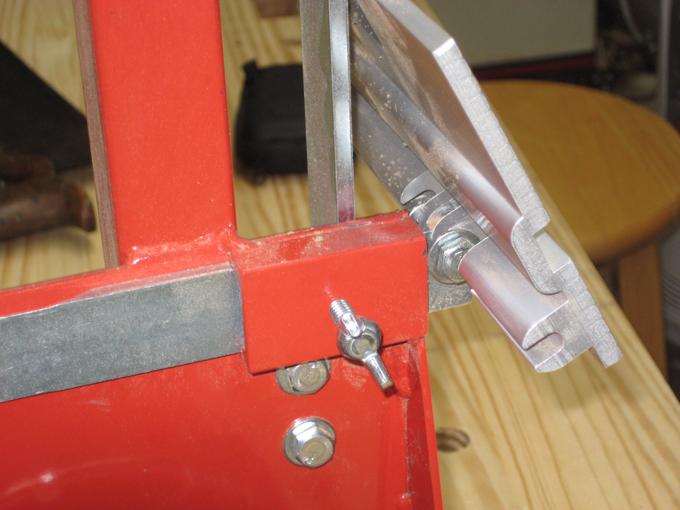
When you first assemble the belt sander, the table may not tilt all the way to 155°. When you set the table to that angle, the table will be too far from the belt. If you look carefully at the picture on the right, you’ll see two washers that protrude from the underside of the table. Those washers may be preventing you from tilting to 155°. That happens when the steel bar is not fully seated in the slot of the aluminum table. I took the table off, put it flat on my bench with the steel bar sticking up and tapped the end of the steel bar with a hammer. That seated the bar completely. After adjusting the table angle several times, you’ll have to do that again. It’s a little annoying, but not a huge deal.
My second criticism is that it has no guard whosoever. That’s good, because I have also used the “back” of the sander and it makes changing belts easy, but when you grind with a 40 grit belt, a few sparks will fly in your face. When grinding, I put the belt off the edge of a table and that helps. I could build a guard, but haven’t done that yet.
Common Questions
I first heard about using a 1" belt sander in Leonard Lee’s book, The Complete Guide to Sharpening. His description was very brief and didn’t answer basic questions I had, so I’m going to try to answer those here.
Brent Beach also uses a belt grinder and gets credit for finally pushing me in this direction.
Which way should the belt rotate?
The belt should rotate toward the table, into the edge. This seems counter intuitive, like the edge would take all the grit off the abrasive, but in practice that does not happen.
Why do you use such a narrow belt?
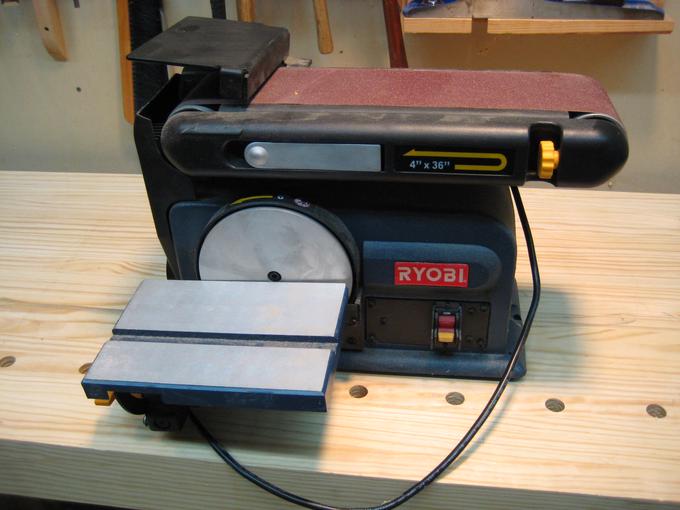
I bought the 4" belt sander you see at the right based on a discussion I read here. I did not build Mr. Cohen’s jig, but instead tried a simple sled that straddled the belt. That did not go well. First of all, without drilling and tapping into the machine (I don’t have any taps), there is not much place to attach the sled. If you build it around the machine, then you have a huge machine for one simple task. Also, it’s important to consider that any mechanism you build must allow the belt to come off.
Even with my rickety sled setup, I was able to test this method enough to determine it would not work easily. The problem was that the platten behind the belt was not flat. It was concave, so when I ground the bevel against the belt, the blade would end up convex. The corners would be ground significantly more than the middle. If that happens on the 1" sander, it’s no problem because you can grind more in the middle of the blade. With a 4" belt, you can’t target a small section of the blade, so your platen has to be either convex or dead flat. Correcting the platen was a larger problem than I was willing to tackle.
Finally, the Ryobi sander was big, heavy, and loud. It’s difficult to move around the shop. I don’t recommend it for sharpening.
What grit abrasives should I use?
I use 40, 80, and 120, depending on the amount of metal removal required. I do not use any of the really fine grits like the Lee Valley sells because all my honing is done by hand.
You can buy the belts from Lee Valley, Viel Tools, Klingspor’s Woodworking Shop, or Supergrit.
Where do I buy a Viel grinder?
I wasted a lot of time trying to figure this out, so let me save you some effort!
Lee Valley sells the grinder without a motor. For the motor, Grainger #3K771 will work, but Grainger is a pain to buy from as an individual. You can order an identical part from mscdirect.com. You could also try a local motor supplier or Craigslist. Remember that if you supply the motor, you also need a cord and switch.
I bypassed all that and just bought directly from Viel Tools. The price was about the same as buying the pieces individually. The part number with the motor is S5-M. They also sell the belts and had reasonable shipping charges. I have no affiliation other than a satisfied customer.
Is the belt speed too high?
No. The bottom wheel, which is 6" in diameter, is the drive wheel. The motor turns at 1725 RPM, so the belt speed is about 2700 SFPM. I was concerned that would be too fast, but it works fine. Blade heat is not a significant issue.
Everybody else uses a wheel grinder. Does a belt grinder really work?
Yes, a belt sander really works. Yes, many people promote wheel grinders, but I’m not clear why.
What nobody seems to tell you about wheel grinders is that setting the angle on a grinder is hard. You basically want the wheel to contact the exact center of the bevel, which is difficult. It’s easy to be off by 5° or more, which can make a significant difference in the edge. What’s worse is that the thickness of the blade impacts the bevel angle. So it’s not like you set it up once and are done. You have to set it for every single blade you grind!
The other issue with wheel grinders is the cost. You will probably need wheels, a tool rest, and a dressing tool. By the time you get all those, you are in the same price range as the belt grinder.
Do you use any of the Viel jigs to help you grind?
No. Viel sells a jig for planer knives and a jig for chisels. I have not tried either one, but I don’t see how they could possibly work. To grind with a jig like that, you have to be able to adjust the table to be square to the belt. There is no adjustment in that dimension.
The standard tilting table works fine. You can learn this. It’s not difficult.
